Are you eager to kickstart your WordPress blogging journey on the right track?
Welcome to NameHassle.com – Your Premier Domain Name Generator. We understand that for many, the prospect of starting a wordPress blog can be rather daunting, particularly if you don’t consider yourself tech-savvy. But fear not, you’re far from alone in this sentiment.
With our extensive experience assisting over 100,000 users in their blogging endeavors, we’ve taken the initiative to create a comprehensive, step-by-step guide specially designed for WordPress beginners, regardless of your technical proficiency.
The process of starting a WordPress blog is incredibly user-friendly, whether you’re a youthful 20-year-old or a seasoned blogger at 60. Should you ever require assistance along the way, our expert team stands ready to provide you with complimentary blog setup support.
Are you prepared to take the first step and commence your WordPress blogging journey? Look no further – click the link below to begin the process and start a WordPress blog the right way.
Click Here to Start a WordPress Blog Now!
What do you need to start a WordPress blog?
Creating a WordPress blog is a breeze when you have the right guidance and tools at your disposal. At NameHassle.com – Your Trusted Domain Name Generator, we’re here to make the process seamless for you. To start a WordPress blog, you’ll need three key ingredients:
- A Domain Name Idea: This is the unique name that will define your blog, such as namehassle.com.
- A Web Hosting Account: Your blog needs a home on the internet, and that’s where web hosting comes in. It’s where your website will live and thrive.
- Your Undivided Attention for 30 Minutes: Yes, you read it correctly. You can kickstart your blog from scratch in less than half an hour, and we’ll be your guide every step of the way.
Our comprehensive tutorial will cover the following essential topics:
- How to Register a Custom Domain Name for Free: We’ll show you how to secure a domain name that suits your blog without breaking the bank.
- How to Choose the Best Web Hosting: Discover the hosting solution that aligns perfectly with your WordPress blog’s needs.
- How to Install and Start a WordPress Blog: We’ll walk you through the installation and setup process, making it a breeze.
- How to Change Your Blog Design Template: Customize the look and feel of your blog to reflect your unique style and branding.
- How to Write Your First Blog Post: Dive into the world of content creation with our expert tips.
- How to Customize Your WordPress Blog with Plugins: Explore the world of plugins to enhance your blog’s functionality.
- How to Add a Contact Form: Connect with your readers by learning how to add a contact form to your blog.
- How to Set Up Google Analytics Tracking: Monitor your blog’s performance and gain valuable insights into your audience.
- How to Optimize Your Website for SEO: Maximize your blog’s visibility on search engines with effective SEO strategies.
- How to Make Money From Your Blog: Unlock the potential for monetization and turn your passion into profit.
- Resources to Learn and Master WordPress: We’ll provide you with valuable resources to continue learning and mastering the art of WordPress.
Are you ready to take the first step? Let’s dive in and start your WordPress blog journey together!
Get Started on Your WordPress Blog Now!
Step 1: Choose Your Blog Name and Platform
When embarking on the exciting journey to start a WordPress blog, your first and foremost decision is crucial – picking the right blog name and platform. Here at NameHassle.com – Your Trusted Domain Name Generator, we’ll ensure you make the right choice.
Beginners often stumble by selecting an unsuitable blogging platform. But you won’t make that mistake because you’re here with us. For a staggering 95% of users, the ideal choice is WordPress.org, also known as self-hosted WordPress.
Why WordPress? It’s open source, which means it’s entirely free to use. With WordPress, you have the power to install plugins, tailor your blog’s design to your liking, and, most importantly, generate income from your blog without constraints (for a comparison, see the difference between WordPress.com and WordPress.org).
Consider this: WordPress reigns as the number one website platform used by all thriving blogs, including our very own. To put things in perspective, a staggering 43% of all websites on the internet run on WordPress!
Now, you might be pondering, why is WordPress free? Is there a catch? The answer is simple: there’s no catch. It’s free because you take charge of the setup and hosting.
In essence, you’ll need two key components: a domain name and web hosting.
- A domain name serves as your website’s address on the internet, the name people type to reach your blog, much like google.com or namehassle.com.
- Web hosting is where your website files find their home, your blog’s residence on the internet. Every blog requires web hosting.
Typically, a new domain name costs around $14.99 per year, and web hosting plans usually start at $7.99 per month. This might seem like a significant expense, especially for beginners just setting out on their blogging journey.
Thankfully, we’ve partnered with Bluehost, an officially recommended hosting provider by WordPress, to bring you a fantastic offer. Our users can enjoy a free domain name and over 60% off on web hosting costs.
→ Click here to Claim this Exclusive Bluehost offer ←
You can also explore other popular WordPress hosting companies like SiteGround or Hostinger, and still, our blog setup tutorial will be applicable.
For beginners, we recommend Bluehost for several reasons. They are one of the oldest and most reputable web hosting companies on the internet, hosting millions of websites, including many of our own. Bluehost has been working closely with WordPress since 2005, demonstrating their commitment to the platform. In fact, they’ve assured us that if you can’t get your blog online within 30 minutes by following this tutorial, our expert team will step in and complete the process for you at no cost. They will cover the expenses, so you don’t have to. Contact us for free blog setup assistance.
NOTE: At NameHassle.com, we value transparency. If you sign up with Bluehost through our referral link, we will earn a small commission, but you won’t incur any extra costs (in fact, you’ll save money and get a free domain). We only recommend products that we personally use and believe will bring value to our readers.
Now, let’s move forward and purchase your domain and hosting.
- Open Bluehost in a new window and follow along.

- Click on the green “Get Started Now” button to initiate the process.
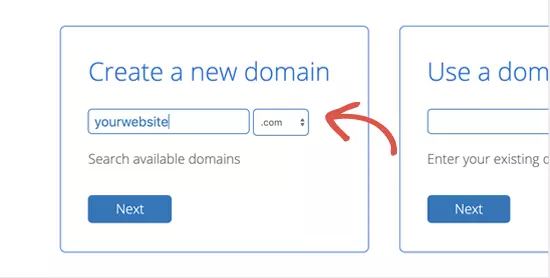
- On the next screen, select the plan that suits your needs (basic and plus are the most popular choices).
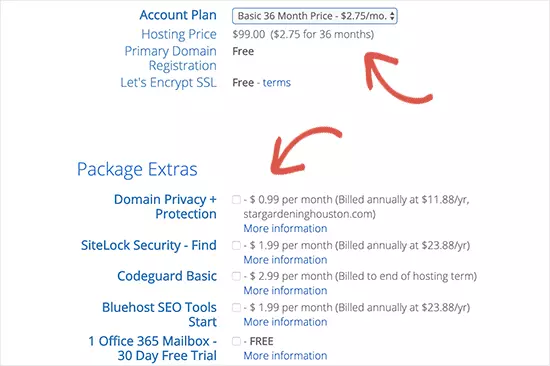
- You’ll be prompted to enter your chosen domain name for your website.
- Lastly, provide your account information and finalize the package details to complete the process. We recommend opting for the 12-month plan as it offers the best value.
- On the following screen, you’ll encounter optional extras that you can add to your purchase. Whether or not you choose to add them right away is entirely up to you. You can always incorporate them later if you find the need.
- Once completed, you’ll receive an email containing instructions on how to access your web hosting control panel (cPanel). This is where you’ll manage everything, from support to emails and, most importantly, where you’ll install WordPress.
Step 2: Install WordPress Blogging Software
Now that you’ve taken the crucial first step to start a WordPress blog with Bluehost, the next phase is to install the WordPress blogging software. The good news is that, when you sign up with Bluehost through our link, they make this process incredibly easy for you. This means you can get started with building your blog right away.
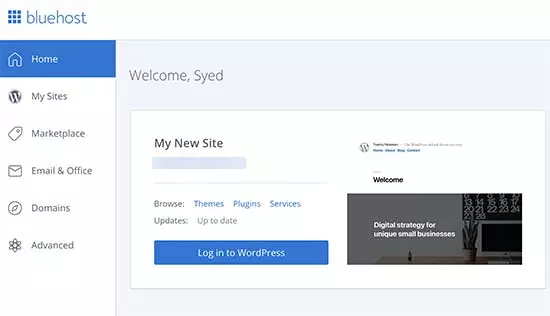
Here’s how to go about it:
- Simply log in to your Bluehost account.
- Locate and click on the “Login to WordPress” button within your Bluehost dashboard.
- Alternatively, you can access your WordPress blog by typing “yoursite.com/wp-admin/” directly into your web browser.
If you happen to be using a different WordPress blog hosting service, such as SiteGround, Hostinger, or WP Engine, rest assured that most of these providers now also offer automatic WordPress installation. This is great news for those who may not consider themselves tech-savvy, as it streamlines the process of kicking off your blogging journey.
Once WordPress is set up, you’re all set to start creating your blog pages, customizing your blog’s design, and diving into the world of blogging.
Step 3: Selecting Your WordPress Theme
The visual appeal of your WordPress blog is primarily determined by your blog theme. When you first visit your blog, it might look somewhat like this, with the default WordPress theme:
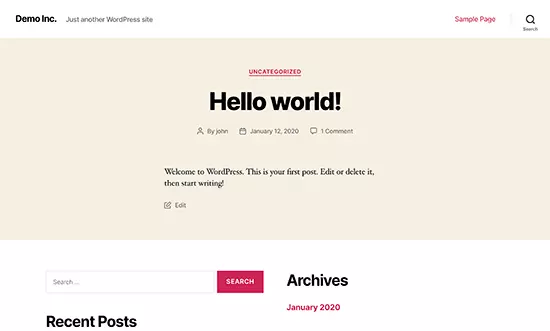
While functional, this default theme may not be the most enticing choice for most people. The exciting part of creating your WordPress blog lies in customizing its look and feel to match your unique style.
Fortunately, there’s a vast selection of pre-made WordPress themes available for your site. Some are free, while others come with a premium price tag.
Here’s how you can change your theme:
- Navigate to your WordPress dashboard and click on “Appearance” » “Themes.”
- Click the “Add New” button.
- On the next screen, explore over 10,000 free WordPress themes from the official WordPress.org themes directory. You can filter themes by popularity, freshness, featured status, and other attributes like industry or layout.
- Hover your mouse over a theme to see a “Preview” button. Clicking this button will open a theme preview, allowing you to visualize how the design would appear on your website.
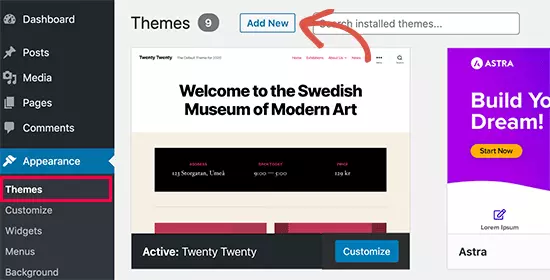
It’s important to note that the preview may not exactly match the screenshot, as you’ll have the opportunity to customize and configure it later. What matters most at this stage is the design, color scheme, typography, and other design elements.
When selecting the perfect WordPress theme, aim for simplicity in design. This keeps your blog clean, user-friendly, and visually appealing.
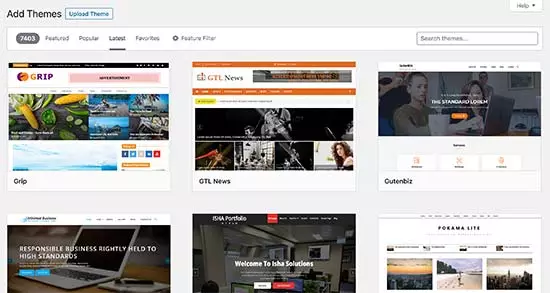
If you need assistance in choosing a theme, refer to our comprehensive guide on “9 Things You Should Consider When Selecting the Perfect WordPress Theme.”
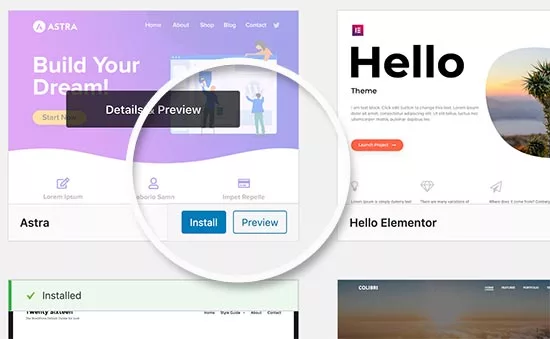
Once you’ve found the theme that resonates with your vision, hover your mouse over it, and an “Install” button will appear. Click it to initiate the installation process. After installation, the “Activate” button will replace the “Install” button. Click “Activate” to make the theme live on your blog.
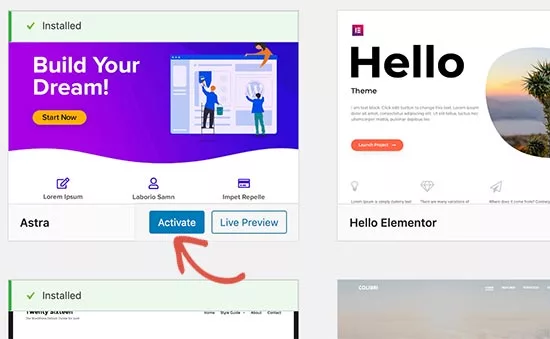
With your theme in place, you can further personalize it by clicking the “Customize” link under the “Appearance” menu. Depending on your chosen theme, you’ll find built-in widgets and customization options that allow you to fine-tune your blog’s design.
For even more control over your design, consider using a WordPress page builder like SeedProd or Divi. These tools empower you to create a custom header, footer, sidebar, and more without the need for HTML coding.
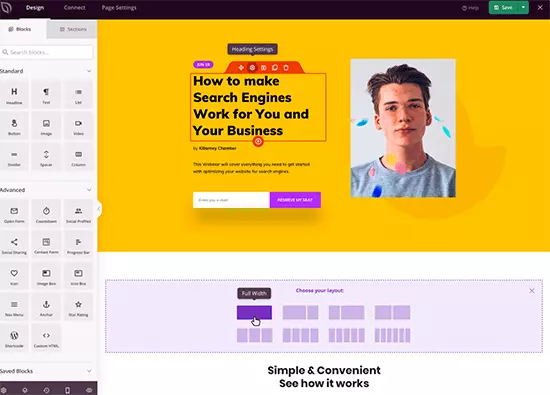
These plugins offer greater design freedom than platforms like Wix or Squarespace while harnessing the full power of the WordPress content management system.
With your WordPress theme selected and customized to your liking, you’re now ready to embark on creating your very first blog post.
Step 4: Crafting Your Inaugural Blog Post
To commence your journey to start a WordPress blog, it’s time to create your very first blog post. Follow these steps to get started:
- Navigate to your WordPress dashboard and click on “Posts” » “Add New.”
- You’ll be directed to the post editor area, where you can begin crafting your inaugural blog post.
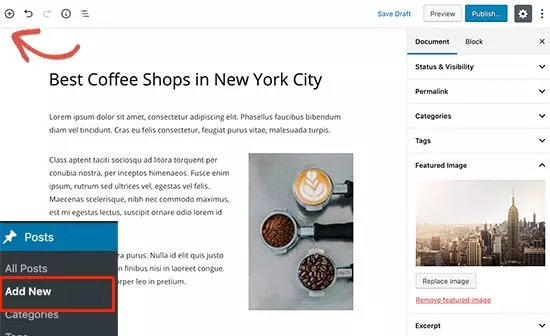
WordPress employs a block-based editor, empowering you to fashion captivating content layouts for your blog posts. To become acquainted with this editor, check out our comprehensive WordPress block editor tutorial.
Once you’ve penned your thoughts, don’t hesitate to click on the “Publish” button, located at the top-right corner of the screen, to share your blog post with the world.

On the post management screen, you’ll encounter various sections, such as “Categories” and “Tags.” These tools help you organize your blog posts into well-structured sections. If you’re new to these concepts, we strongly recommend reading our informative guide on understanding the difference between categories vs. tags.
To maximize your proficiency with the post management screen, delve into our article detailing how to add a new post in WordPress, complete with a helpful video tutorial. This resource covers a wide array of shortcuts and techniques, including embedding videos, incorporating images, formatting headings, creating table of contents, using sub-headers, constructing bullet lists, adding compelling call-to-action buttons, seamlessly integrating social media posts, and much more.
Now, let’s address a common source of confusion among beginners: the distinction between the “Posts” and “Pages” menus in the WordPress dashboard. To clarify this topic, we’ve compiled a comprehensive guide elucidating the difference between posts vs. pages in WordPress.
If you find yourself in need of inspiration for your next blog post, we’ve got you covered with some valuable resources:
- Utilize our free blog post idea generator tool, designed by NameHassle, to spark your creativity.
- Explore our compilation of 103 blog post ideas that are sure to captivate your readers.
- Discover 73 types of blog topics that have been tried and tested to resonate with audiences.
- Master the art of crafting a compelling blog post with our guide, complete with structural insights and examples.
For seasoned bloggers looking to elevate their content strategy, consider strategically selecting specific topics through keyword research. This approach not only enhances your content’s visibility in Google search but also drives more traffic to your blog.
To help you get started with keyword research, we’ve prepared a step-by-step guide tailored for beginners, employing the very same method we utilize at NameHassle.
Now that you’ve taken this crucial step in creating your first blog post, you’re well on your way to becoming a proficient blogger. Continue to explore and hone your skills, and watch your blog flourish.
Step 5: Enhance Your Blog with Plugins & Customizations
After crafting your debut blog post, it’s time to elevate your WordPress blog by incorporating additional essential elements such as a contact page, image galleries, sliders, email lists, forums, and more.
To introduce these features seamlessly, you’ll want to leverage the power of WordPress plugins.
What Are WordPress Plugins?
Think of WordPress plugins as handy apps that expand the capabilities of your website – all without requiring you to write a single line of code.
The options are virtually limitless, with over 60,000 WordPress plugins readily available in the free WordPress plugin directory alone. No matter what functionality you wish to add to your blog, you can bet there’s a plugin for it.
How to Install a WordPress Plugin
To get started with enhancing your WordPress blog through plugins, follow these simple steps:
- Check out our step-by-step guide on how to install a WordPress plugin.
- Once you’re familiar with plugin installation, explore the following essential features you can introduce to your blog:
Essential Features for Your WordPress Blog:
- Contact Page: Allow your readers to get in touch with you effortlessly by adding a contact page to your blog.
- Image Galleries: Showcase your visuals with elegance and organization through image galleries.
- Sliders: Create dynamic, eye-catching slideshows to engage and captivate your audience.
- Email Lists: Build and manage your email subscriber list for effective communication with your readers.
- Forums: Foster a sense of community and facilitate discussions by adding a forum to your blog.
These plugins enable you to tailor your blog to your precise needs and preferences, enhancing user experience and engagement.
So, now that you’ve dipped your toes into the world of WordPress blogging and are well-equipped with the knowledge to wield plugins effectively, it’s time to take your blog to the next level. Explore the vast array of plugins available to add features that resonate with your vision for your blog.
Creating a Contact Form for Your WordPress Blog
Every website, including your WordPress blog, should have a contact form to facilitate direct communication with your users. While WordPress doesn’t come equipped with a built-in contact form feature, adding one to your site is a breeze with the help of a WordPress form builder plugin.
Why Choose WPForms Lite
For this purpose, we recommend the WPForms Lite plugin. It’s the free version of the immensely popular WPForms plugin, which currently holds the top spot on our list of the best contact form plugins for WordPress. Remarkably, over 6 million websites trust and utilize WPForms!
Installing WPForms Lite
To get started, follow these steps:
- Go to your WordPress dashboard and navigate to the “Plugins” » “Add New” page.
- In the search box, type “WPForms.”
- Locate the WPForms Lite plugin and click “Install” followed by “Activate.”
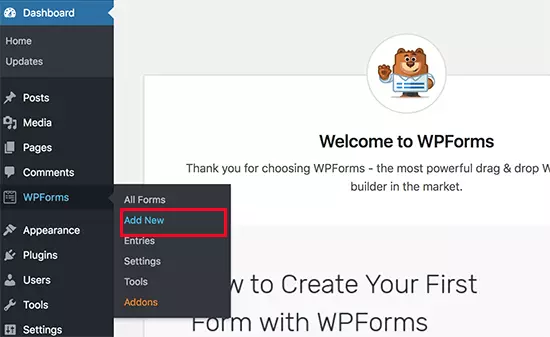
Creating Your First Contact Form
Once the plugin is activated, proceed to the WPForms settings. To create your first contact form, go to “WPForms” » “Add New.”
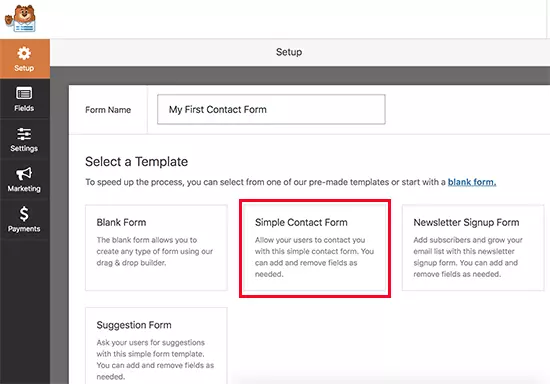
This action will open the WPForms builder interface.
- Begin by assigning a name to your contact form.
- Click on the ‘Simple Contact Form’ template to select it as your starting point.
Customizing Your Contact Form
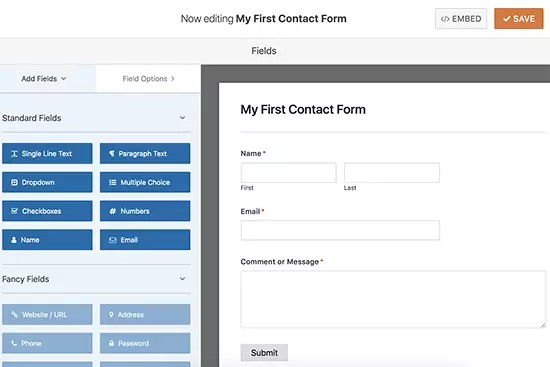
WPForms will automatically generate a basic contact form for you, complete with all the essential fields. You can modify any field by simply clicking on it, or you can introduce new fields from the left column.
After you’ve finished customizing your form, remember to save your changes by clicking the “Save” button in the top right corner of the builder. Then, exit the form builder.
Embedding Your Contact Form
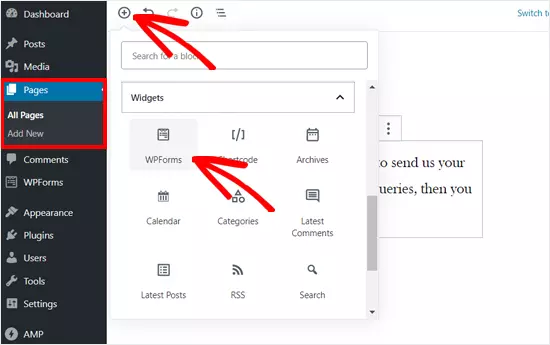
With your contact form ready, it’s time to make it accessible on your WordPress blog. Follow these steps:
- Create a new page in WordPress by navigating to “Pages” » “Add New.” Name it ‘Contact’ or any other suitable title.
- In the editing screen, add the WPForms block to the editor.
- Select the form you created earlier from the dropdown menu, and WPForms will load a live preview of the form right within the editor.
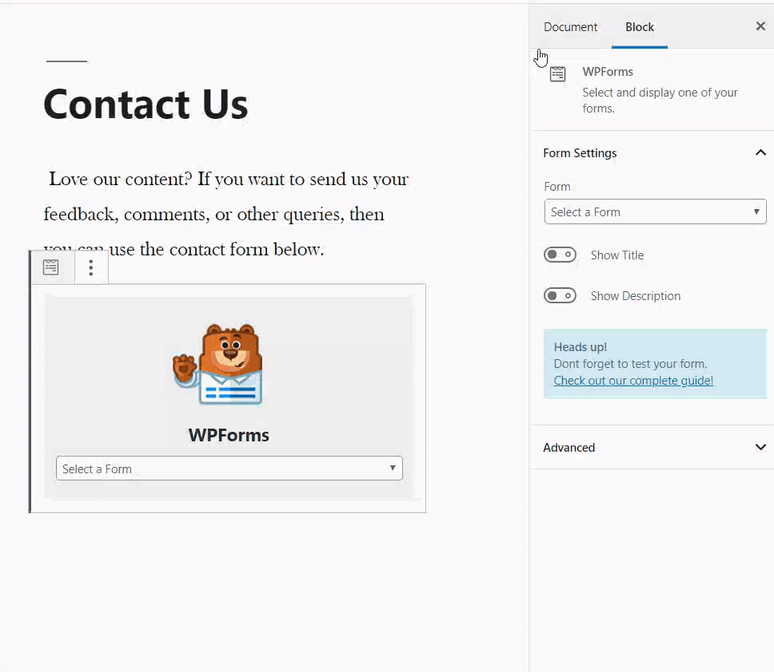
Testing Your Contact Form
After configuring the form on your page, save and publish the page. You can then visit it in your browser to witness your contact form in action. To ensure everything is functioning correctly, it’s advisable to test the form by sending a message to yourself.
If, for any reason, you encounter issues with receiving notifications from your form, consult our guide on how to troubleshoot WordPress not sending emails.
For more in-depth instructions and insights, explore our step-by-step guide on how to create a contact form in WordPress.
As a blogger, WPForms offers versatility beyond simple contact forms. You can utilize it to craft reader surveys, polls, guest post submission forms, and much more, making it a valuable tool that evolves with your blogging journey.
[Explore WPForms for Your WordPress Blog Now!]
Setting Up Google Analytics Tracking for Your WordPress Blog
Google Analytics is an indispensable tool for gaining insights into your blog’s performance. It provides valuable data on the number of visitors to your site, their origins, and their interactions with your content. By installing Google Analytics when you start your blog, you can track its growth over time and make informed decisions to optimize your content and strategy.
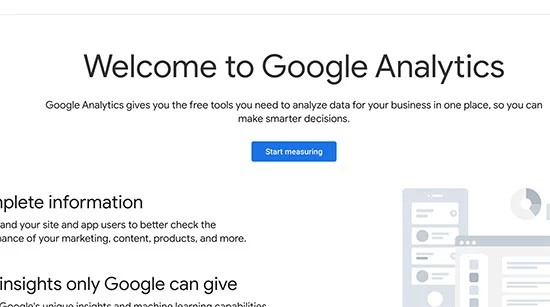
Here’s how to set up Google Analytics tracking for your WordPress blog:
Step 1: Sign Up for Google Analytics
- Begin by visiting the Google Analytics website and sign in using your Gmail account.
- Once logged in, proceed to sign up for a free Google Analytics account.
- You will be prompted to provide your information and your website’s URL during the sign-up process.
- After completing these steps, you will receive your unique Google Analytics tracking code.
Step 2: Adding Google Analytics to Your WordPress Blog
While you have your Google Analytics tracking code, we recommend using a WordPress plugin to simplify the process and seamlessly integrate Google Analytics with your blog.
MonsterInsights is the ideal plugin for this purpose, and it offers a free version that is trusted by over 3 million websites. Here’s how to set it up:
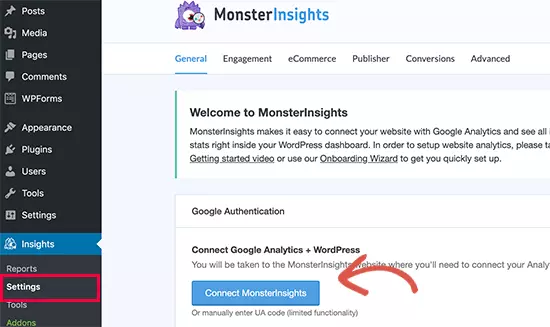
- In your WordPress admin area, go to the “Plugins” section and install the MonsterInsights plugin.
- Once installed, activate the plugin to get started.
- Visit the Insights » Settings page to configure the plugin settings.
- Click on the ‘Connect MonsterInsights’ button to initiate the connection between Google Analytics and your WordPress site.
- Follow the on-screen instructions provided by MonsterInsights to complete the setup process.
- After successfully setting up MonsterInsights, you’ll be able to access your website’s analytics reports directly from your WordPress dashboard under the MonsterInsights tab.
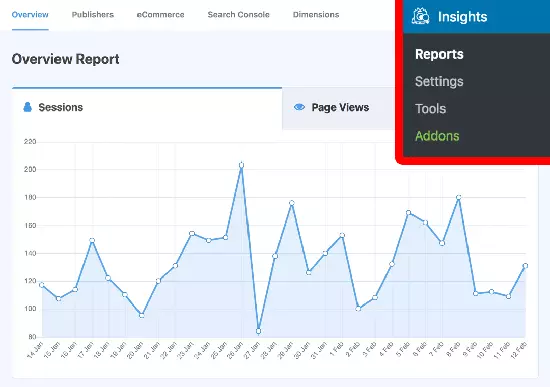
With Google Analytics integrated into your WordPress blog through MonsterInsights, you can now monitor your website’s performance, track visitor behavior, and gain valuable insights to optimize your content and grow your blog effectively.
For detailed instructions and further insights, be sure to explore our comprehensive guide on how to install Google Analytics in WordPress.
Mastering SEO Optimization for Your WordPress Blog
Many newcomers to the world of blogging overlook a critical aspect: SEO, or Search Engine Optimization. SEO is the key to ensuring that users can find your blog on search engines, ultimately driving more traffic to your site. If you aim to increase your blog’s visibility and reach, it’s imperative to implement SEO strategies right from the outset.
Step 1: Installing the All in One SEO Plugin
To embark on your SEO journey, start by installing and activating the All in One SEO (AIOSEO) plugin. AIOSEO is the ultimate WordPress SEO plugin that streamlines the optimization process for your blog.
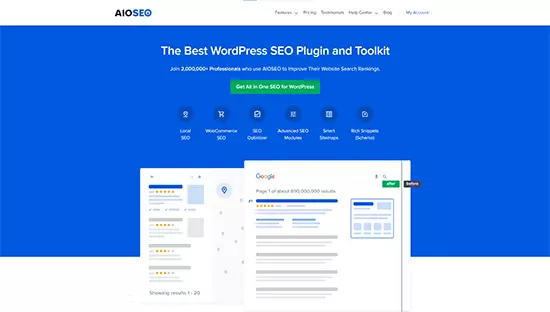
Upon activation, the plugin provides a quick configuration wizard that guides you through the setup process. It’s designed to help you with critical tasks such as:
- Creating a WordPress sitemap.
- Crafting well-researched keywords and meta descriptions.
- Implementing schema markup for enhanced search results.
- And much more.
AIOSEO simplifies SEO optimization, making it accessible to bloggers of all levels. The free version of AIOSEO is highly effective and trusted by over 3 million websites, including NameHassle.
Step 2: Exploring Keyword Research Tools
In addition to utilizing a WordPress SEO plugin like AIOSEO, you can further enhance your blog’s SEO by employing a keyword research tool. These powerful tools assist in generating new content ideas that align with popular search queries related to your niche.
By identifying keywords that resonate with your target audience, you can create content that not only attracts readers but also ranks favorably in search engine results. Additionally, these tools offer insights into the keywords your competitors are ranking for, enabling you to craft superior content that outperforms theirs.
This approach empowers you to maximize your blog’s traffic right from the start. For comprehensive guidance on conducting keyword research tailored to your blog’s needs, consult our newbie’s guide on how to effectively perform keyword research.
By following these steps and integrating SEO optimization into your blogging strategy, you’ll enhance your blog’s visibility, attract a larger audience, and establish a strong online presence. SEO isn’t just a tactic; it’s an investment in the long-term success of your WordPress blog.
Exploring Additional WordPress Plugins and Customizations
The world of WordPress offers a vast array of plugins and customizations that can enhance your website’s functionality and appearance. As a newcomer, it’s common to feel overwhelmed when searching for the right plugins to suit your needs. At NameHassle, we understand this challenge and are here to guide you through the process.
Here are some expert-recommended WordPress plugins that you should consider exploring as you embark on your journey to start a WordPress blog:
1. Backup – Duplicator: Ensuring the safety of your website is paramount. Duplicator is an exceptional WordPress backup plugin that allows you to create regular backups of your site. These backups are invaluable in case something unexpected happens to your blog.
2. Security – Sucuri Security: Website security is crucial. Sucuri Security is a free security scanner designed specifically for WordPress. Our comprehensive step-by-step WordPress security guide for beginners can further assist you in securing your blog effectively.
3. Performance – WP Rocket or WP Super Cache: Website speed is a vital factor in user experience. To enhance the performance of your WordPress blog, consider using WP Rocket (a premium option) or WP Super Cache (a free alternative). Our article on WordPress speed and performance provides step-by-step instructions to optimize your site’s speed.
4. Design & Customization – SeedProd or Divi Page Builder: Tailoring your website’s design to your preferences is essential. SeedProd and Divi Page Builder are excellent tools for customizing your homepage design, creating custom landing pages, and even developing custom themes without the need for coding. Our article on the best WordPress page builders offers in-depth comparisons.
5. Traffic & Subscribers – PushEngage: To effectively engage with your visitors even after they leave your site, consider implementing push notifications through PushEngage. It’s one of the top five traffic sources on NameHassle. Learn how to add push notifications in WordPress for more details.
6. Email Marketing – Constant Contact or HubSpot: Building and maintaining an email subscriber list is essential for successful email marketing. Constant Contact and HubSpot are reputable email marketing services that you can explore. To boost your email subscriber count, we recommend using the OptinMonster free plugin, which enables you to create high-converting popups, scroll boxes, and call-to-action elements.
If you’re curious about all the plugins and tools we utilize on our website, don’t hesitate to check out NameHassle’s Blueprint. This comprehensive list contains all the tools we employ to grow the NameHassle blog.
For additional recommendations, consider our expert’s selection of must-have WordPress plugins and tools for all websites, personally handpicked by our founder, Jacob Lewis.
As you delve deeper into the WordPress ecosystem, these plugins and customizations will empower you to optimize your blog’s functionality and appearance, ensuring an exceptional user experience for your readers.
Monetizing Your WordPress Blog: Turning Your Passion into Profit
After successfully creating your personalized blog and tailoring it to your preferences, you’re likely eager to explore the avenues of making money from your newfound platform. The good news is that there are various ways to monetize your blog; however, it’s essential to understand that there’s no magic formula for instant wealth. Steer clear of the allure of flashy cars and mansions depicted in get-rich-quick schemes, as they often lead to disappointment.
Unlike the typical “make money online” articles, we’ve crafted an extensive guide on how to effectively generate income from your WordPress blog. This comprehensive 4000+ word guide encapsulates over 15 years of online wisdom, making it a must-read for anyone looking to monetize their blog. Keep in mind that achieving financial success through blogging requires dedication and hard work—there are no shortcuts.
Here are some of the best methods to make money from your blog:
1. Google AdSense
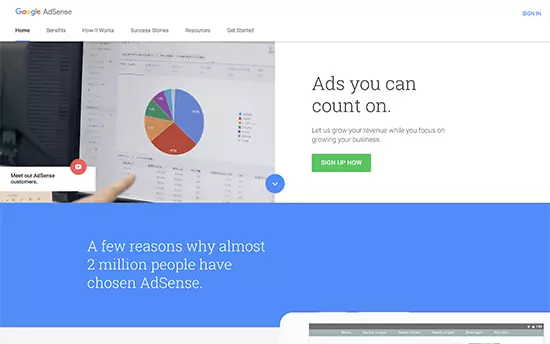
Many bloggers generate revenue by displaying ads on their blogs, and Google AdSense is a top choice for this purpose. Acting as a bridge between you and advertisers, Google AdSense enables advertisers to bid on keywords relevant to your content, ensuring you receive competitive rates for displaying ads on your site. For detailed instructions on integrating Google AdSense into your WordPress blog, refer to our article.
2. Affiliate Marketing

Affiliate marketing ranks as the second most popular monetization strategy among bloggers. Essentially, you recommend products or services you believe in to your readers, and when they make a purchase, you earn a referral commission. The key to successful affiliate marketing lies in promoting high-quality products and services you genuinely use and trust.
WordPress offers a range of affiliate marketing plugins and tools to optimize your earnings, such as PrettyLinks or ThirstyAffiliates. Our step-by-step affiliate marketing guide for beginners provides invaluable insights into selecting the right affiliate program and strategies to monetize your blog.
3. Online Store

Many bloggers boost their income by selling products or services directly from their blogs. This can encompass physical products, digital downloads like ebooks, artwork, music, or even consulting services.
For selling digital products, consider using Easy Digital Downloads, a plugin renowned for its features and simplicity. If you aim to sell physical products, WooCommerce stands out as the best eCommerce plugin for WordPress, widely adopted worldwide.
Creating an online store with WordPress is an achievable endeavor, as detailed in our comprehensive guide.
Some bloggers opt to build Amazon affiliate stores, enabling them to sell products from Amazon and earn commissions without the hassle of managing their inventory.
In addition to these three methods, WordPress offers various other opportunities for monetizing your blog. You can cater to niche audiences through specialized blogs, such as review blogs, fashion blogs, or food blogs with recipes, unlocking unique income prospects.
Transforming your blog into a membership site allows you to offer premium content and courses, broadening your income potential further. Our detailed guide on creating and selling online courses with WordPress provides valuable insights into this endeavor.
As you venture into monetizing your WordPress blog, keep in mind that success is an ongoing journey that rewards dedication and passion. By exploring these avenues and putting in the effort, you can turn your blog into a lucrative venture while sharing your passion and knowledge with the world.
Mastering WordPress with NameHassle

Welcome to NameHassle, your trusted resource for mastering WordPress, tailored for small businesses, bloggers, and WordPress website owners of all levels. Our mission is to empower you with cutting-edge and user-friendly WordPress tutorials, ensuring that you harness the full potential of this versatile platform.
NameHassle’s WordPress Learning Hub
To embark on your journey of WordPress mastery, make the most of our resources:
- NameHassle Dictionary: Dive into the world of WordPress by acquainting yourself with essential terminology through our comprehensive dictionary. Whether you’re a newcomer or seeking to refine your understanding, this is the ideal starting point.
- NameHassle Videos: If you’re new to WordPress, our collection of 23 informative videos is your gateway to mastering the platform. These videos cover a wide range of topics and are designed to make learning WordPress a breeze.
- NameHassle Blog: Explore our central repository for a treasure trove of WordPress tutorials. Whether you’re looking to enhance your website’s functionality, optimize its performance, or troubleshoot issues, you’ll find expert guidance here.
Join the NameHassle Community
For vibrant discussions and mutual support, consider becoming a part of our thriving NameHassle community:
- NameHassle Engage (Facebook Group): Join our free Facebook group, NameHassle Engage, where over 94,000 members, including beginners and non-techy users, collaborate to maximize their WordPress experience. Share insights, seek advice, and grow together.
Stay Connected with NameHassle
Never miss out on valuable WordPress insights and updates by staying connected with us:
- NameHassle’s YouTube Channel: Subscribe to our YouTube channel, where we regularly publish video tutorials to facilitate your WordPress learning journey.
- NameHassle on Google: When you have WordPress-related questions, simply type your query into Google and add “NameHassle” in front of it. This smart trick ensures you receive precise answers from our resources.
Personalized Support from NameHassle
Should you ever encounter a challenge or question that eludes you, don’t hesitate to reach out. NameHassle’s dedicated support team is at your service. Use our contact form to send us a message, and our friendly experts will guide you toward the solution you need. We take pride in assisting users like you in getting started and thriving with WordPress.
At NameHassle, we are committed to being your unwavering partner on your WordPress journey. Whether you’re a newcomer or a seasoned user, our goal is to empower you with the knowledge and resources you need to make the most of WordPress.
Frequently Asked Questions: Everything You Need to Know to Start Your WordPress Blog
Congratulations on your journey to start a WordPress blog with NameHassle! As you embark on this exciting adventure, you may have questions, and we’ve got the answers you need. Here are the most commonly asked questions about creating a blog:
Can I create a blog without WordPress?
Yes, there are other blogging platforms available, but WordPress is the best choice for those seeking complete ownership and creative freedom over their blog.
Can I build a blog without hosting?
No, web hosting is essential as it stores your website files. You’ll need your own domain and web hosting to begin your blog.
How do I come up with a good blog name?
Blog names can be based on your name or the topic/industry you’re interested in. Use our AI-powered business name generator or blog name generator for blog name ideas.
What is the best blogging niche?
Choosing the right niche is crucial. Our experts have researched the 7 best blogging niches to consider and created a list of the 18 most popular blog types for inspiration.
How much does it cost to start a blog?
Costs vary based on add-ons. Check out our guide on WordPress website costs and money-saving tips. Most blogging tools offer free trials or money-back guarantees.
Can I create a blog without my parents knowing?
Yes, you can make your WordPress blog private and hidden from the internet. Follow our guide on making your WordPress blog completely private.
Can I start a WordPress blog and make money with Google AdSense?
Absolutely! Learn how to add Google AdSense to your WordPress blog with our step-by-step guide.
How can I create a blog and remain anonymous?
To blog anonymously, ensure your domain has WHOIS privacy enabled. Use a pseudonym, create a unique email, and avoid posting personal information. Find more details in our guide on blogging anonymously with WordPress.
How do I add a podcast to my WordPress blog?
WordPress makes it easy to add a podcast. Follow our step-by-step guide on starting a podcast with WordPress.
Can I build a blog in my own language?
Yes, WordPress is available in multiple languages. You can select your language during installation or from the WordPress settings. Many themes and plugins also support various languages.
How do I create a blog in multiple languages?
Learn how to create a multilingual website in WordPress with our comprehensive guide.
Can I design a blog with no coding skills?
Absolutely! WordPress themes are customizable without coding. Themes like Astra offer one-click starter websites, while powerful builders like Divi provide drag-and-drop design options. You can even create a custom theme without coding.
Can I add a photography gallery to my blog?
Yes, WordPress has a built-in gallery feature for adding photo galleries to your blog posts. Professional photographers can use premium gallery plugins for better showcasing and selling photos.
How can I create a professional email address for my blog?
Create a professional business email address for free to enhance your blog’s credibility and partnership opportunities.
Can I switch blogging platforms later?
If you started with another platform, you can easily switch to WordPress. We have detailed tutorials on switching from platforms like Medium, Blogger, and WordPress.com to WordPress.
Where do I find photos for my blog?
Discover high-quality, royalty-free stock photos for your blog, videos, and social media in our beginner’s guide.
We hope these FAQs provide clarity as you embark on your WordPress blogging journey with NameHassle. For more valuable tips, check out our articles on driving traffic to your new WordPress site and essential post-installation tasks.
Don’t forget to subscribe to our YouTube Channel for WordPress video tutorials and find us on Pinterest, Twitter and Facebook for the latest updates and insights. Happy blogging!
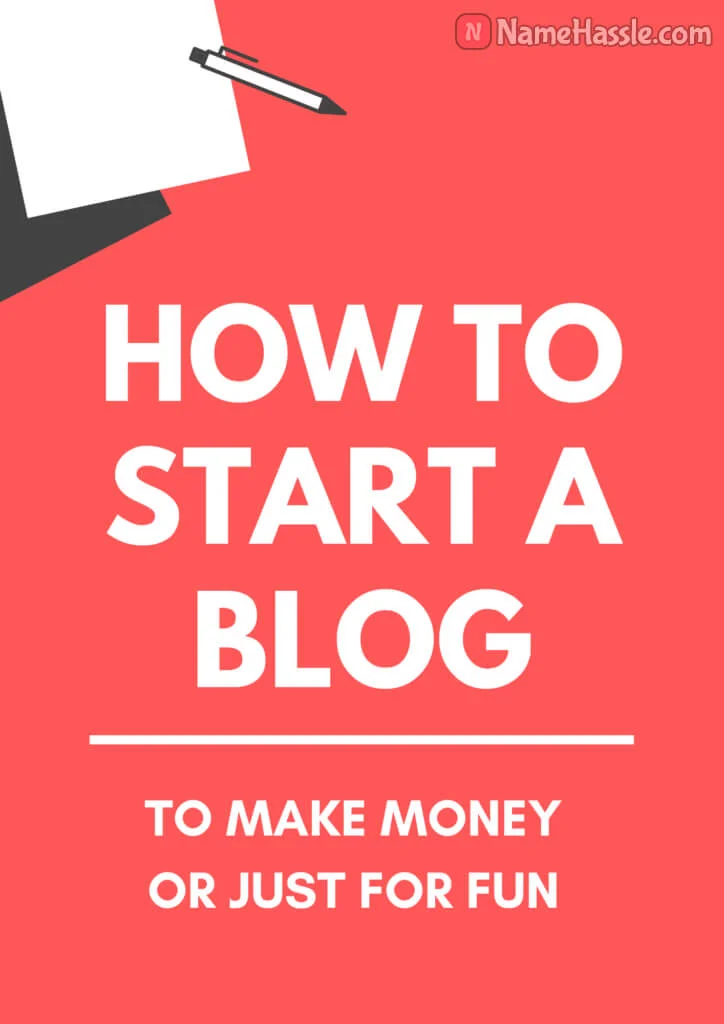
NameHassle.com - Your Ultimate Domain Name Generator
Discover the Perfect Domain Name for Your Online Adventure with NameHassle.
Effortlessly generate creative and available domain names in seconds. Say goodbye to domain naming hassles and start building your online presence today!
You've Chosen A Business Name. Now What?
Congratulations on selecting your business name!
Now, take the next exciting steps: secure a domain to establish your online presence, create a logo that captures the essence of your brand, and craft a slogan that embodies your values.
Don't forget to trademark your unique brand identity, safeguarding your brand's future.
Ready to make your business name unforgettable? Let's get started on this journey! 🚀
To further enhance your brand, explore:


